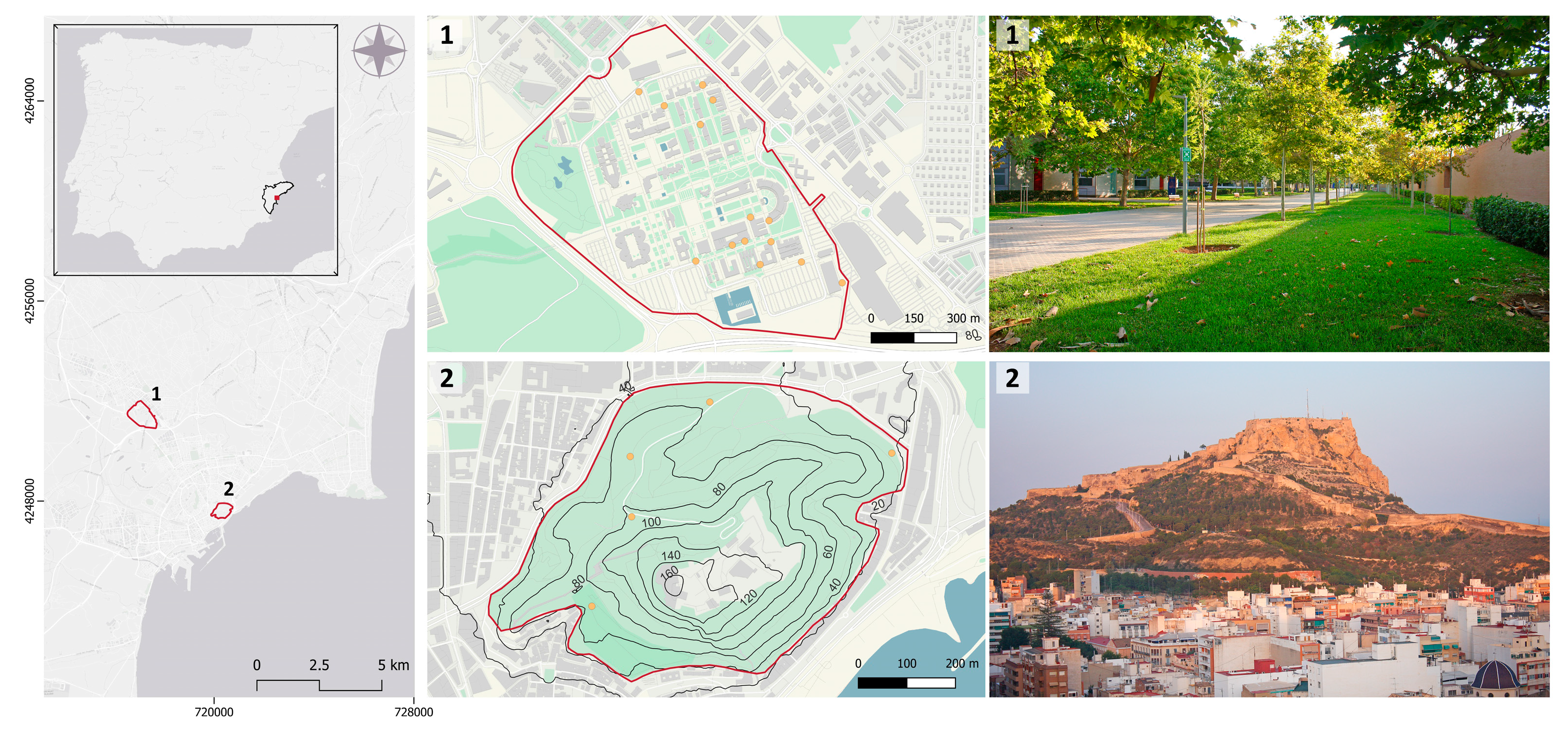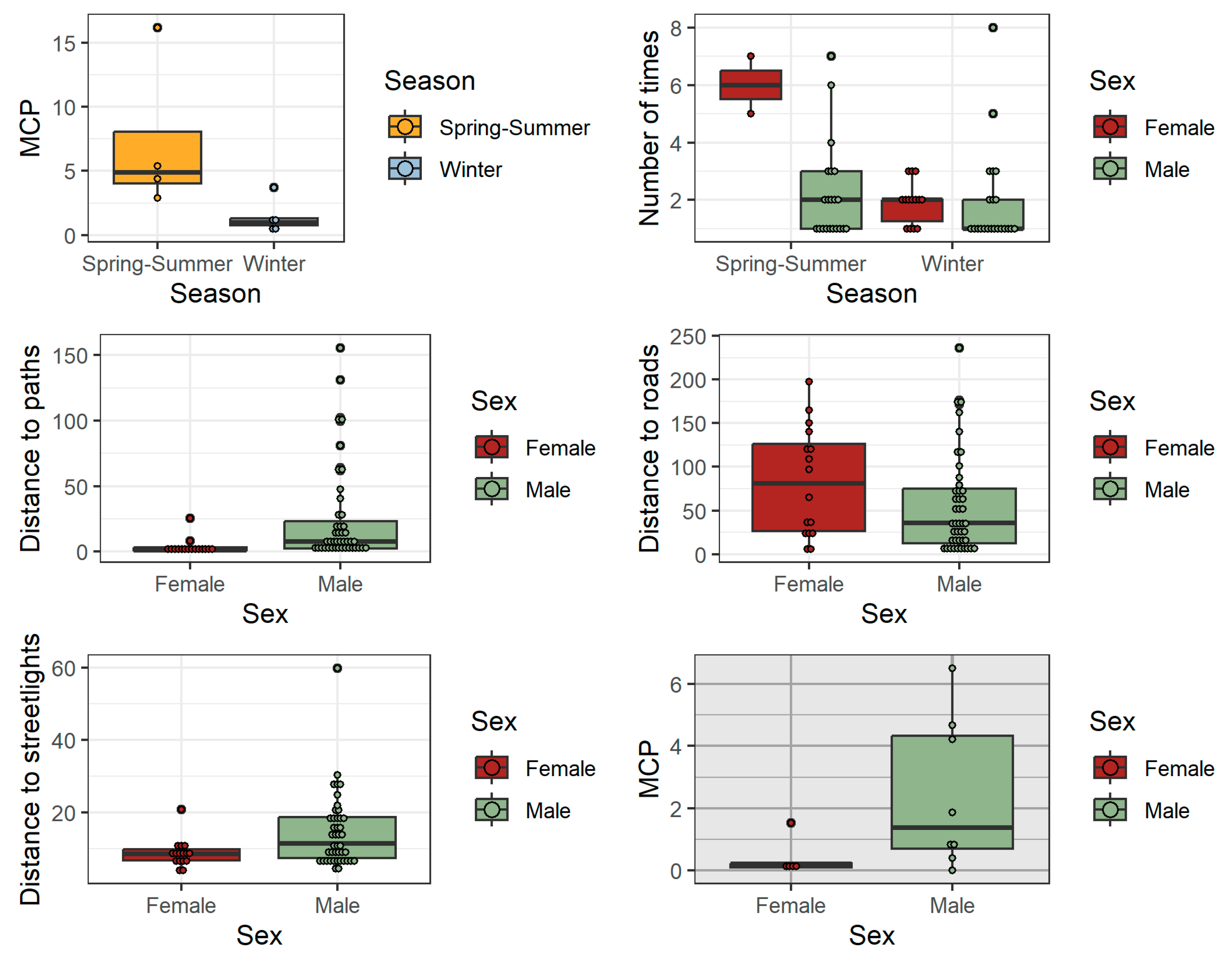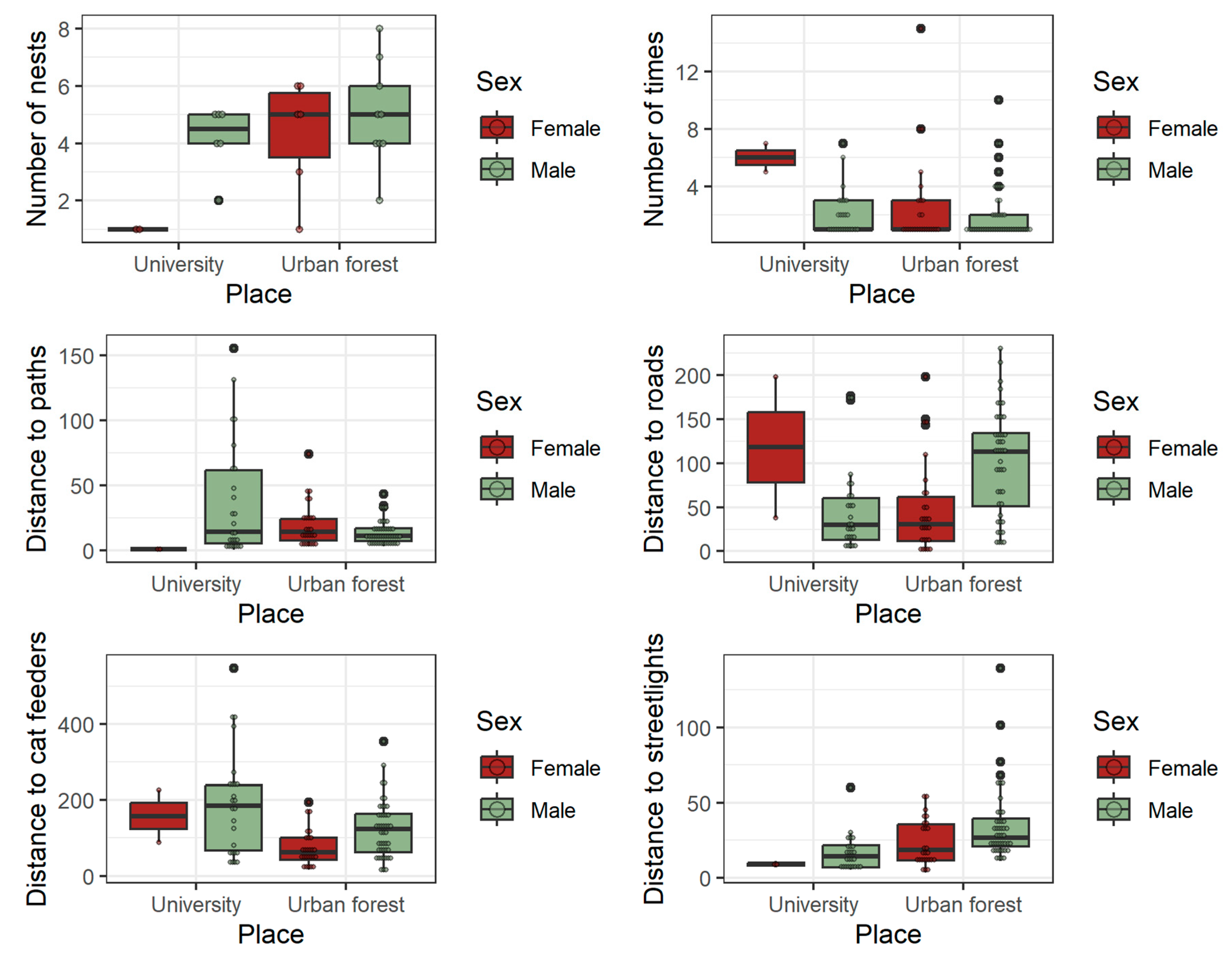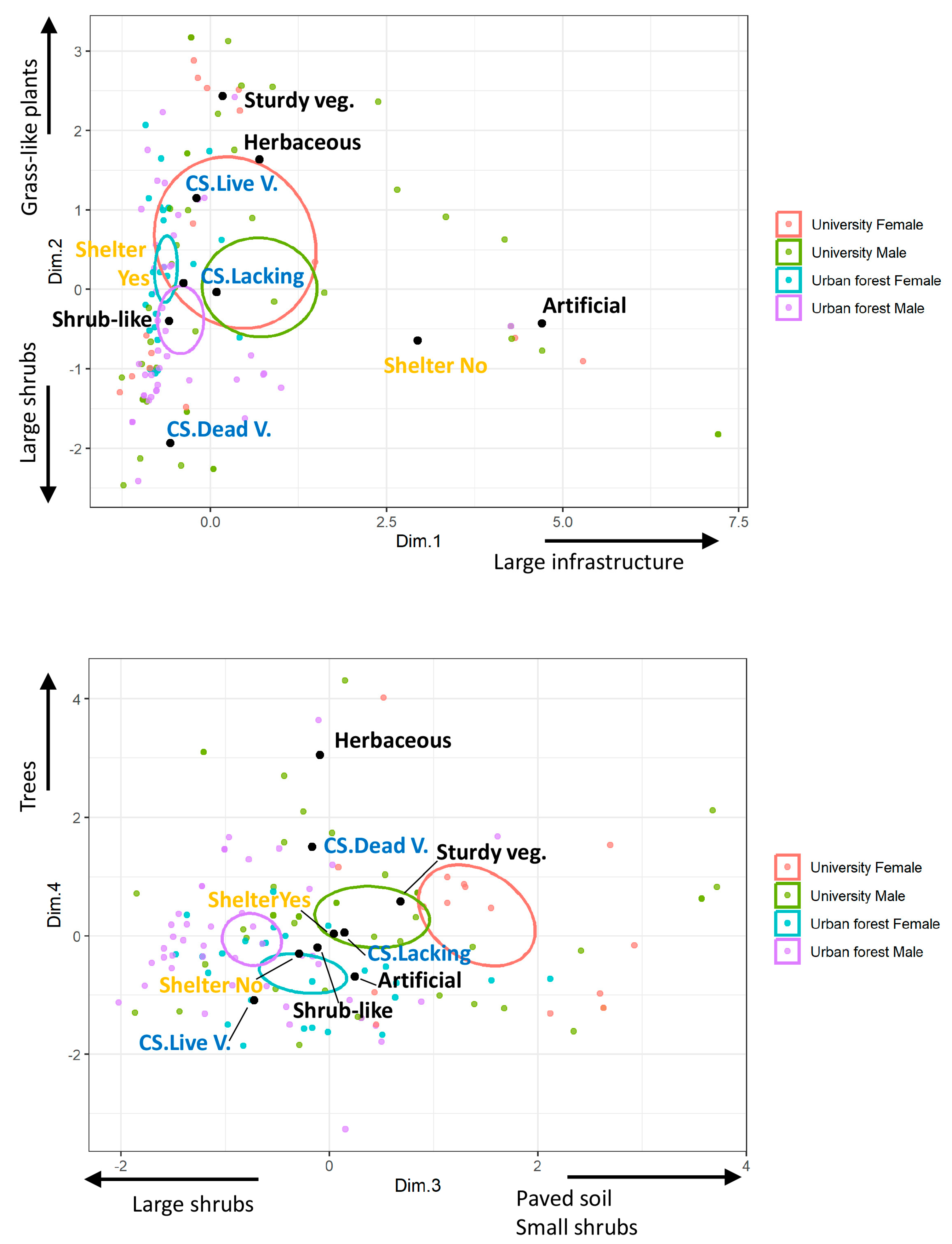Nesting Ecology of European Hedgehogs (Erinaceus europaeus) in Urban Areas in Southeast Spain: Nest Habitat Use and Characteristics
Abstract
Simple Summary
Abstract
1. Introduction
2. Materials and Methods
2.1. Study Area
2.2. Hedgehog Capture and GPS Attachment
2.3. Logger Sampling Setup and Nest Locations
2.4. Nest and Habitat Characterisation
2.4.1. Nest Characteristics
2.4.2. Habitat around Nests
2.5. Statistical Analyses
3. Results
3.1. Seasonal and Sex Differences within Localities
3.2. Differences between Localities in Spring–Summer
3.3. Nest Characteristics
3.4. Nest Location and Habitat around Nest
4. Discussion
5. Conclusions
Supplementary Materials
Author Contributions
Funding
Institutional Review Board Statement
Informed Consent Statement
Data Availability Statement
Acknowledgments
Conflicts of Interest
References
- Boitani, L.; Reggiani, G. Movements and activity patterns of Hedgehogs (Erinaceus europaeus) in Mediterranean coastal habitats. Z. Saugetierkd 1984, 49, 193–206. [Google Scholar]
- Young, R.P.; Davison, J.; Trewby, I.D.; Wilson, G.J.; Delahay, R.J.; Doncaster, C.P. Abundance of hedgehogs (Erinaceus europaeus) in relation to the density and distribution of badgers (Meles meles). J. Zool. 2006, 269, 349–356. [Google Scholar] [CrossRef]
- Reeve, N. Hedgehogs; T. & A.D. Poyser Ltd.: London, UK, 1994. [Google Scholar]
- Jones, C.; Norbury, G. Habitat use as a predictor of nest raiding by individual hedgehogs Erinaceus europaeus in New Zealand. Pacif. Conserv. Biol. 2006, 12, 180–188. [Google Scholar] [CrossRef]
- Hubert, P.; Julliard, R.; Biagianti, S.; Poulle, M.L. Ecological factors driving the higher hedgehog (Erinaceus europeaus) density in an urban area compared to the adjacent rural area. Landsc. Urban Plan. 2011, 103, 34–43. [Google Scholar] [CrossRef]
- Bearman-Brown, L.E.; Baker, P.J.; Scott, D.; Uzal, A.; Evans, L.; Yarnell, R.W. Over-winter survival and nest site selection of the west European hedgehog (Erinaceus europaeus) in arable dominated landscapes. Animals 2020, 10, 1449. [Google Scholar] [CrossRef]
- Haigh, A.; O’Riordan, R.M.; Butler, F. Nesting behaviour and seasonal body mass changes in a rural Irish population of the Western hedgehog (Erinaceus europaeus). Acta Theriol. 2012, 57, 321–331. [Google Scholar] [CrossRef]
- Morris, P. Winter Nests of the Hedgehog (Erinaceus europaeus L.). Oecologia 1973, 11, 299–313. [Google Scholar] [CrossRef]
- Marco-Tresserras, J.; López-Iborra, G.L. The effect of sex on home range in an urban population of European hedgehogs Erinaceus europaeus at the southern edge of the species distribution. Anim. Biodivers. Conserv. 2022, 45, 269–279. [Google Scholar] [CrossRef]
- Riber, A.B. Habitat use and behaviour of European hedgehog Erinaceus europaeus in a Danish rural area. Acta Theriol. 2006, 51, 363–371. [Google Scholar] [CrossRef]
- Pettett, C.E.; Johnson, P.J.; Moorhouse, T.P.; Macdonald, D.W. National predictors of hedgehog Erinaceus europaeus distribution and decline in Britain. Mamm. Rev. 2018, 48, 1–6. [Google Scholar] [CrossRef]
- Hof, A.R. A Study of the Current Status of the Hedgehog (Erinaceus europaeus), and its Decline in Great Britain Since 1960. Ph.D. Thesis, University of London, Egham, UK, 2009. [Google Scholar]
- Hof, A.R.; Bright, P.W. The value of agri-environment schemes for macro-invertebrate feeders: Hedgehogs on arable farms in Britain. Anim. Conserv. 2010, 13, 467–473. [Google Scholar] [CrossRef]
- Yarnell, R.W.; Pettett, C.E. Beneficial land management for hedgehogs (Erinaceus europaeus) in the United Kingdom. Animals 2020, 10, 1566. [Google Scholar] [CrossRef]
- McKinney, M.L. Urbanization as a major cause of biotic homogenization. Biol. Conserv. 2006, 127, 247–260. [Google Scholar] [CrossRef]
- Bateman, P.W.; Fleming, P.A. Big city life: Carnivores in urban environments. J. Zool. 2012, 287, 1–23. [Google Scholar] [CrossRef]
- Yarnell, R.W.; Pacheco, M.; Williams, B.; Neumann, J.L.; Rymer, D.J.; Baker, P.J. Using occupancy analysis to validate the use of footprint tunnels as a method for monitoring the hedgehog Erinaceus europaeus. Mamm. Rev. 2014, 44, 234–238. [Google Scholar] [CrossRef]
- van de Poel, J.L.; Dekker, J.; Van Langevelde, F. Dutch hedgehogs Erinaceus europaeus are nowadays mainly found in urban areas, possibly due to the negative effects of badgers Meles meles. Wildl. Biol. 2015, 21, 51–55. [Google Scholar] [CrossRef]
- Pettett, C.; Moorhouse, T.P.; Johnson, P.J.; Macdonald, D.W. Factors affecting hedgehog distribution and habitat selection in rural landscapes. Eur. J. Wildl. Res. 2016, 63, 1–12. [Google Scholar] [CrossRef]
- Schaus, J.; Uzal, A.; Gentle, L.K.; Baker, P.J.; Bearman-Brown, L.; Bullion, S.; Gazzard, A.; Lockwood, H.; North, A.; Reader, T.; et al. Application of the Random Encounter Model in citizen science projects to monitor animal densities. Remote Sens. Ecol. Conserv. 2020, 6, 514–528. [Google Scholar] [CrossRef]
- Morris, P.A. Hedgehogs, 4th ed.; Whittet Books: Stansted, UK, 2014. [Google Scholar]
- Haigh, A.; O’Riordan, R.M.; Butler, F. Habitat selection, philopatry and spatial segregation in rural Irish hedgehogs (Erinaceus europaeus). Mammalia 2013, 77, 163–172. [Google Scholar] [CrossRef]
- Morris, P. A study of home range and movements in the hedgehog (Erinaceus europaeus). J. Zool. 1988, 214, 433–449. [Google Scholar] [CrossRef]
- Rautio, A.; Valtonen, A.; Kunnasranta, M. The effects of sex and season on home range in European hedgehogs at the northern edge of the species range. Ann. Zool. Fennici. 2013, 50, 107–123. [Google Scholar] [CrossRef]
- ProtempTM 3 GarantTM Temporization Material. Available online: https://multimedia.3m.com/mws/media/125397O/protemptm-3-garanttm-temporization-material.pdf (accessed on 1 September 2016).
- Reading, R.P.; Kenny, D.; Murdoch, J.; Batdorj, S. Use of dental restorative temporization material for attaching radiotransmitters to hedgehogs. Wildl. Soc. Bull. 2016, 40, 355–358. [Google Scholar] [CrossRef]
- MITECO. Available online: https://www.miteco.gob.es/es/biodiversidad/temas/conservacion-de-especies/buenaspracticascapturaenvivoymarcajefaunasilvestre_aprobadocepnb_tcm30-431702.pdf (accessed on 1 September 2016).
- Barthel, L.M.F.; Hofer, H.; Berger, A. An easy, flexible solution to attach devices to hedgehogs (Erinaceus europaeus) enables long-term high-resolution studies. Ecol. Evol. 2019, 9, 672–679. [Google Scholar] [CrossRef]
- SEMICE Project. Available online: https://www.semice.org//pdf/CARACTERITZACION_HABITAT_ESP.pdf (accessed on 31 January 2017).
- Brooks, M.E.; Kristensen, K.; Van Benthem, K.J.; Magnusson, A.; Berg, C.W.; Nielsen, A.; Skaug, H.J.; Mächler, M.; Bolker, B.M. glmmTMB balances speed and flexibility among packages for zero-inflated generalized linear mixed modeling. R J. 2017, 9, 378–400. [Google Scholar] [CrossRef]
- Lê, S.; Josse, J.; Husson, F. FactoMineR: An R package for multivariate analysis. J. Stat. Softw. 2018, 25, 1–18. [Google Scholar] [CrossRef]
- Jackson, D.B. The breeding biology of introduced hedgehogs (Erinaceus europaeus) on a Scottish Island: Lessons for population control and bird conservation. J. Zool. 2006, 268, 303–314. [Google Scholar] [CrossRef]
- Moran, S.; Turner, P.D.; O’Reilly, C. Multiple paternity in the European hedgehog. J. Zool. 2009, 278, 349–353. [Google Scholar] [CrossRef]
- Reeve, N.J.; Morris, P.A. Construction and use of summer nests by the hedgehog (Erinaceus europaeus). Mammalia 1985, 49, 187–194. [Google Scholar] [CrossRef]
- Rautio, A.; Valtonen, A.; Auttila, M.; Kunnasranta, M. Nesting patterns of European hedgehogs (Erinaceus europaeus) under northern conditions. Acta Theriol. 2013, 59, 173–181. [Google Scholar] [CrossRef]
- Henry, M.; Thomas, D.W.; Al Vaudry, R.É.; Carrier, M. Foraging distances and home range of pregnant and lactating little brown bats (Myotis lucifugus). J. Mammal. 2002, 83, 767–774. [Google Scholar] [CrossRef]
- Koskela, E.; Mappes, T.; Ylonen, H. Territorial behaviour and reproductive success of bank vole Clethrionomys glareolus females. J. Anim. Ecol. 1997, 66, 341–349. [Google Scholar] [CrossRef]
- Sanders, D.; Frago, E.; Kehoe, R.; Patterson, C.; Gaston, K.J. A meta-analysis of biological impacts of artificial light at night. Nat. Ecol. Evol. 2021, 5, 74–81. [Google Scholar] [CrossRef] [PubMed]
- Finch, D.; Smith, B.R.; Marshall, C.; Coomber, F.G.; Kubasiewicz, L.M.; Anderson, M.; Wright, P.G.R.; Mathews, F. Effects of artificial light at night (Alan) on european hedgehog activity at supplementary feeding stations. Animals 2020, 10, 768. [Google Scholar] [CrossRef] [PubMed]
- Lubitz, N.; Bradley, M.; Sheaves, M.; Hammerschlag, N.; Daly, R.; Barnett, A. The role of context in elucidating drivers of animal movement. Ecol. Evol. 2022, 12, e9128. [Google Scholar] [CrossRef] [PubMed]
- Scott, D.M.; Fowler, R.; Sanglas, A.; Tolhurst, B.A. Garden Scraps: Agonistic Interactions between Hedgehogs and Sympatric Mammals in Urban Gardens. Animals 2023, 13, 590. [Google Scholar] [CrossRef]
- Dimelow, E.J. The behaviour of the hedgehog (Erinaceus europaeus L.) in the routine of life in captivity. Proc. Zool. Soc. Lond. 1963, 141, 281–289. [Google Scholar] [CrossRef]
- Parkes, J. Some aspects of the biology of the hedgehog (Erinaceus europaeus L.) in the Manawatu, New Zealand. N. Z. J. Zool. 1975, 2, 463–472. [Google Scholar] [CrossRef]
- Moors, P.J. Observations on the nesting habits of the european hedgehog in the manawatu sand country, New Zealand. N. Z. J. Zool. 1979, 6, 489–492. [Google Scholar] [CrossRef]
- Schoenfeld, M.; Yom-Tov, Y. The biology of two species of hedgehogs, Erinaceus europaeus concolor and Hemiechinus auritus aegyptius, in Israel. Mammalia 1985, 49, 339–356. [Google Scholar] [CrossRef]
- Norton, B.A.; Bending, G.D.; Clark, R.; Corstanje, R.; Dunnett, N.; Evans, K.L.; Grafius, D.R.; Gravestock, E.; Grice, S.M.; Harris, J.A.; et al. Urban meadows as an alternative to short mown grassland: Effects of composition and height on biodiversity. Ecol. Appl. 2019, 29, e01946. [Google Scholar] [CrossRef]
- Huijser, M.P.; Bergers, P.J. The effect of roads and traffic on hedgehog (Erinaceus europaeus) populations. Biol. Conserv. 2000, 95, 111–116. [Google Scholar] [CrossRef]




| Variable | Season | p | Sex | p | Period × Sex | p | M. Days | p | No. Nests | p |
|---|---|---|---|---|---|---|---|---|---|---|
| Number of nests | n.r. | n.r. | n.r. | + | 0.4603 | |||||
| Distance consecutive nests 1 | n.r. | n.r. | + | 0.3854 | ||||||
| MCP nests 1 | + | 0.0898 | + | 0.6996 | ||||||
| Times occupied | + | 0.0034 | − | 0.5931 | − | 0.0021 | + | 0.0072 | ||
| Distance to path | n.r. | + | 0.0014 | n.r. | ||||||
| Distance to road | n.r. | − | 0.099 | n.r. | ||||||
| Distance to cat feeder | n.r. | n.r. | n.r. | |||||||
| Distance to streetlight | n.r. | + | 0.0027 | n.r. |
| Variable | Place | p | Sex | p | Place × Sex | p | M. Days | p | No. Nests | p |
|---|---|---|---|---|---|---|---|---|---|---|
| GLM | ||||||||||
| Number of nests | − | 0.0346 | + | 0.6223 | + | 0.0808 | + | 0.4872 | ||
| Distance consecutive nests 1 | n.r. | + | 0.2882 | |||||||
| MCP nests 1 | + | 0.1190 | + | 0.2430 | ||||||
| GLMM | ||||||||||
| Times occupied | + | 0.0682 | − | 0.0283 | n.r. | + | 0.0017 | |||
| Distance to path | − | 0.0000 | 0.3990 | + | 0.0000 | |||||
| Distance to road | 0.1754 | + | 0.0070 | − | 0.0131 | |||||
| Distance to cat feeder | + | 0.0443 | n.r. | n.r. | ||||||
| Distance to streetlight | − | 0.0000 | + | 0.0129 | n.r. |
| Nest ID | Age & Sex | Month | Study Area | Hosting Structure | Type of Nest | Nest Dimensions (cm) | Nest Material |
|---|---|---|---|---|---|---|---|
| T6 | Juv F | May | Benacantil | Shrub-like plant | Unstructured | Grass | |
| K5 | Ad F | June | Benacantil | Shrub-like plant | Well-structured | 42 × 35 × 31 | Grass, dry leaves and pieces of plastic bags |
| Pi6 | Ad F | June | Benacantil | Shrub-like plant | Unstructured | Grass | |
| Gu5 | Ad M | June | Benacantil | Shrub-like plant | Unstructured | Grass and plastics | |
| FH4 | Ad M | June | Benacantil | Shrub-like plant | Poorly structured | 48 × 44 × 31 | Grass |
| Lu1 | Ad F | August | Benacantil | Shrub-like plant | Poorly structured | 50 × 50 × 70 | Grass, dry leaves, plastic bags, fabric and an umbrella |
| Y2 | Juv M | September | Benacantil | Shrub-like plant | Unstructured | Grass, dry leaves and pieces of plastic bags | |
| Ñ2 | Ad F | October | Benacantil | Shrub-like plant | Well-structured | 30 × 50 × 60 | Grass |
| L5 | Ad F | October | Benacantil | Shrub-like plant | Unstructured | Grass | |
| S4 | Ad M | October | Benacantil | Herbaceous plant | Burrow | Grass stump | |
| B2 | Ad M | January | UA | Shrub-like plant | Well-structured | 60 × 39 × 30 | Dry leaves Bamboo |
| C1 | Ad F | February | UA | Shrub-like plant | Well-structured | 53 × 35 × 16 | Dry leaves Pittosporum sp. |
| Rl5 | Ad M | June | UA | Herbaceous plant | Unstructured | Grass | |
| H3(v) | Ad M | June | UA | Sturdy plant | Burrow | Palm tree stump | |
| CR4 | Juv M | December | UA | Shrub-like plant | Unstructured | Dry leaves, plastic bags and chocolate wrapper |
| University | Urban Forest | |||
|---|---|---|---|---|
| Female | Male | Female | Male | |
| Shrub-like plants | 37.50 | 55.81 | 100.00 | 95.56 |
| Acacia dealbata | 0.00 | 2.33 | - | - |
| Agapanthus sp. | 0.00 | 2.33 | - | - |
| Agave sp. | 0.00 | 4.65 | - | - |
| Bamboo | 6.25 | 11.63 | - | - |
| Cupressus sempervirens | 6.25 | 6.98 | - | - |
| Genista sp. | - | - | 3.85 | 0.00 |
| Lavandula sp. | 6.25 | 2.33 | - | - |
| Lonicera sp. | - | - | 0.00 | 2.22 |
| Mesembryanthemum sp. | 6.25 | 2.33 | - | - |
| Nerium oleander | 0.00 | 4.65 | - | - |
| Origanum sp. | 6.25 | 0.00 | - | - |
| Osyris quadripartita | - | - | 0.00 | 6.67 |
| Phagnalon saxatile | - | - | 3.85 | 0.00 |
| Phoenix sp. | - | - | 0.00 | 2.22 |
| Pistacia lentiscus | 0.00 | 4.65 | 0.00 | 4.44 |
| Pittosporum sp. | 6.25 | 13.95 | - | - |
| Rhamnus lycioides | - | - | 0.00 | 2.22 |
| Rosmarinus officinalis | - | - | 3.85 | 0.00 |
| Salsola oppositifolia | - | - | 84.62 | 77.78 |
| Tetraclinis sp. | - | - | 3.85 | 0.00 |
| Sturdy plants | 43.75 | 16.28 | - | - |
| Cortaderia selloana | 6.25 | 4.65 | - | - |
| Palm tree stump | 0.00 | 2.33 | - | - |
| Hedera helix | 37.50 | 9.30 | - | - |
| Herbaceous plants | 6.25 | 9.30 | 0.00 | 2.22 |
| Graminea sp. | 6.25 | 4.65 | 0.00 | 2.22 |
| Phragmites australis | 0.00 | 2.33 | - | - |
| Stipa tenacissima | 0.00 | 2.33 | - | - |
| Artificial structure | 12.50 | 18.60 | 0.00 | 2.22 |
| Wooden box | 6.25 | 0.00 | - | - |
| Office trailer | 6.25 | 0.00 | - | - |
| Building | 0.00 | 11.63 | - | - |
| Stone wall | 0.00 | 2.33 | 0.00 | 2.22 |
| Metal ramp | 0.00 | 2.33 | - | - |
| Road tunnel | 0.00 | 2.33 | - | - |
| No. of nests | 16 | 43 | 26 | 45 |
| No. of hedgehogs | 6 | 10 | 6 | 9 |
| Diversity H’ | 2.10 | 2.77 | 0.64 | 0.94 |
| Dim.1 | Dim.2 | Dim.3 | Dim.4 | Dim.5 | Dim.6 | Dim.7 | |
|---|---|---|---|---|---|---|---|
| eigenvalue | 2.56 | 1.98 | 1.66 | 1.56 | 1.45 | 1.26 | 1.10 |
| Cumulative % of variance | 16.02 | 28.37 | 38.75 | 48.51 | 57.55 | 65.41 | 72.27 |
| Continuous variables (habitat around the nest) | |||||||
| Leaf litter | 0.472 | −0.250 | −0.009 | 0.484 | −0.008 | 0.362 | 0.189 |
| Grass-like plants | −0.126 | 0.859 | −0.009 | 0.106 | −0.270 | 0.148 | −0.037 |
| Bare soil | −0.020 | 0.191 | −0.273 | −0.086 | 0.696 | 0.083 | −0.040 |
| Paved soil | −0.091 | −0.214 | 0.777 | 0.088 | −0.056 | −0.089 | −0.151 |
| Rocks | −0.073 | −0.111 | −0.002 | −0.298 | 0.021 | −0.017 | 0.760 |
| Branches | 0.097 | 0.183 | −0.057 | 0.027 | 0.240 | −0.264 | −0.123 |
| Small shrubs | −0.309 | −0.192 | 0.590 | −0.401 | 0.286 | 0.147 | 0.002 |
| Large shrubs | −0.318 | −0.489 | −0.676 | 0.129 | −0.269 | −0.254 | −0.081 |
| Trees | −0.173 | −0.178 | 0.265 | 0.636 | 0.081 | 0.059 | −0.231 |
| Large infrastructure | 0.856 | −0.067 | 0.061 | −0.168 | −0.241 | 0.157 | 0.044 |
| Small infrastructure | 0.232 | 0.256 | −0.045 | 0.213 | 0.569 | −0.403 | −0.159 |
| Categorical variables (structure containing the nest) | |||||||
| Main structure | 0.843 | 0.453 | 0.343 | 0.279 | 0.204 | 0.183 | |
| Complementary structure | 0.225 | 0.206 | 0.522 | 0.153 | |||
| Shelter | 0.441 | 0.087 | |||||
| Dimension | Place | p | Sex | p | Season | p |
|---|---|---|---|---|---|---|
| 1 | + UA | 0.0023 | n.s. | n.s. | ||
| 2 | + UA | 0.0395 | − Male | 0.0118 | n.s. | |
| 3 | + UA | 0.0000 | − Male | 0.0013 | n.s. | |
| 4 | + UA | 0.0028 | n.s. | n.s. | ||
| 5 | n.s. | n.s. | n.s. |
Disclaimer/Publisher’s Note: The statements, opinions and data contained in all publications are solely those of the individual author(s) and contributor(s) and not of MDPI and/or the editor(s). MDPI and/or the editor(s) disclaim responsibility for any injury to people or property resulting from any ideas, methods, instructions or products referred to in the content. |
© 2023 by the authors. Licensee MDPI, Basel, Switzerland. This article is an open access article distributed under the terms and conditions of the Creative Commons Attribution (CC BY) license (https://creativecommons.org/licenses/by/4.0/).
Share and Cite
Marco-Tresserras, J.; López-Iborra, G.M. Nesting Ecology of European Hedgehogs (Erinaceus europaeus) in Urban Areas in Southeast Spain: Nest Habitat Use and Characteristics. Animals 2023, 13, 2453. https://doi.org/10.3390/ani13152453
Marco-Tresserras J, López-Iborra GM. Nesting Ecology of European Hedgehogs (Erinaceus europaeus) in Urban Areas in Southeast Spain: Nest Habitat Use and Characteristics. Animals. 2023; 13(15):2453. https://doi.org/10.3390/ani13152453
Chicago/Turabian StyleMarco-Tresserras, Jana, and Germán M. López-Iborra. 2023. "Nesting Ecology of European Hedgehogs (Erinaceus europaeus) in Urban Areas in Southeast Spain: Nest Habitat Use and Characteristics" Animals 13, no. 15: 2453. https://doi.org/10.3390/ani13152453
APA StyleMarco-Tresserras, J., & López-Iborra, G. M. (2023). Nesting Ecology of European Hedgehogs (Erinaceus europaeus) in Urban Areas in Southeast Spain: Nest Habitat Use and Characteristics. Animals, 13(15), 2453. https://doi.org/10.3390/ani13152453





